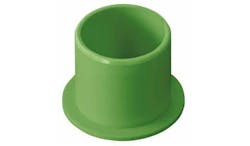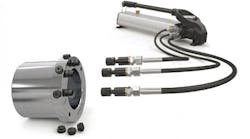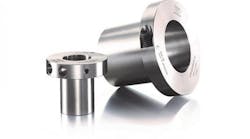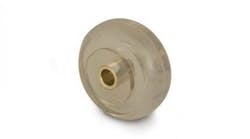iglide N54 Plastic Bushing Made of Renewable Materials
An ecological plastic bushing made of 54% raw, renewable materials, iglide N54 plastic bushings use vegetable oil rather than the more traditionally used crude oil. They are ideal for low-load applications in a variety of different industries such as consumer products, general mechanical engineering, and furniture.
Every iglide plastic bushing uses solid lubricants embedded inside millions of tiny chambers that cannot be pressed out. This means the bushings do not require any oil or grease and so no contaminants are released into the environment. In addition, an iglide plastic bushing is lighter than its metal counterpart, which leads to reduced energy consumption.
Furthermore, less energy is required for the production of plastics compared to metals. For example, the energy from four gallons of crude oil is necessary to produce four cups of aluminum, and the energy from three gallons of crude oil is necessary to produce four cups of steel. In comparison, it only takes 0.48 gallons of crude oil to create four cups of plastic and igus expects this value to fall even further based on continued breakthroughs in the field of vegetable-oil-based plastics.
- The biopolymer based on renewable resources
- Based on renewable resources
- Universal use
- Lubrication and maintenance-free
When to use:
- For applications with sporadic movements at low to medium loads
- At quasi-static loads
- If the environmental impact of a product needs to be optimized
Dynamic, Against steel 0.15 to 0.23 ?pv Value, Max. (dry) 14,300 psi ? fpmRadioactive Radiation Max. 1 ? 104 GyMechanical PropertiesModulus of Elasticity 261,100 psi, test method DIN 53457Flexural Strength (at 20°C/68°F) 10,150 psi, test method DIN 53452Pressure Load 4,350 psiShore-D Hardness 74, test method DIN 53505Max. Recommended Surface Pressure 5,221.4 psi (36.0 MPa)Max. Running Speed, Rotating, Continous 157 fpm (0.8 m/s)Max. Running Speed, Rotating, Short-Term 295 fpm (1.5 m/s)Max. Running Speed, Oscillating, Continous 118 fpm (0.6 m/s)Max. Running Speed, Oscillating, short-term 217 fpm (1.1 m/s)Max. Running Speed, Linear, Continous 197 fpm (1.0 m/s)Max. Running Speed, Linear, Short-Term 394 fpm (2.0 m/s)Physical & Thermal PropertiesMax. Long-Term Temp. 176°F (80°C)Max. Short-Term Temp. 248°F (120°C)Lower App. Temp. -40°F (-40°C)Heat Conductivity 0.24 W/(m ? K), test method ASTM C 177Thermal Expansion Coefficient 9 K-1 ? 10-5, test method DIN 53752Electrical PropertiesVolume Resistance >1013 ?cm, test method DIN IEC 93Surface Resistance >1011 ?, test method DIN 53482CertificatesAccording to 2011/65/EU (RoHS 2)



